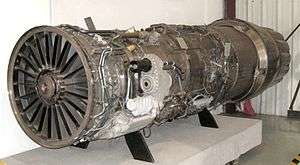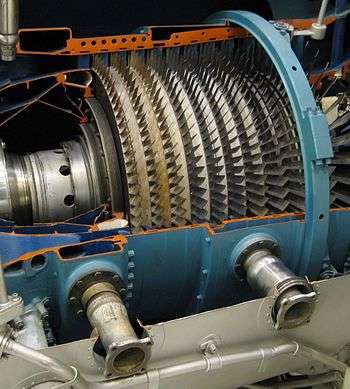Pratt & Whitney TF30
| TF30 | |
|---|---|
 | |
| A TF30 in the Valiant Air Command Warbird Museum, Titusville, Florida | |
| Type | Turbofan |
| National origin | United States |
| Manufacturer | Pratt & Whitney |
| First run | 1960s |
| Major applications | General Dynamics F-111 Aardvark Grumman F-14 Tomcat LTV A-7 Corsair II |
The Pratt & Whitney TF30 (company designation JTF10A[1]) is a military low-bypass turbofan engine originally designed by Pratt & Whitney for the subsonic F6D Missileer fleet defense fighter, but this project was cancelled. It was later adapted with an afterburner for supersonic designs, and in this form it was the world's first production afterburning turbofan, going on to power the F-111 and the F-14A Tomcat, as well seeing use in early versions of the A-7 Corsair II without an afterburner. First flight of the TF30 was in 1964 and production continued until 1986.
Design and development
In 1958, the Douglas Aircraft Company proposed a short-range, four-engined jet airliner to fill the gap below its new DC-8 intercontinental, known internally as the Model 2067. Intended to be marketed the DC-9, it was not directly related to the later twin-engined Douglas DC-9.[1] Pratt & Whitney (P&W) had offered its JT8A turbojet for the airliner, but Douglas preferred to go with a turbofan engine, which would have a greater fuel efficiency than a turbojet. P&W then proposed the JT10A, a half-scale version of its newly developed JT8D turbofan. Development of the new design began in April 1959,[1] using the core of the JT8.[2] Douglas shelved the model 2067 design in 1960, as the targeted US airlines preferred the newly offered Boeing 727.[3]
In 1960, the United States Navy selected the JT10A, designated TF30-P-1, to power the proposed Douglas F6D Missileer, but the project was canceled in April 1961.[4] Meanwhile, the TF30 had been chosen by General Dynamics for its entrant in the TFX competition for the United States Air Force and USN, which was selected for production as the F-111.[5] The version of the TF30 for the F-111 included an afterburner.
Operational history
F-111
.jpg)
The F-111A, EF-111A and F-111E used the TF30-P-103 (aka P-3) turbofan.[6] The F-111 had problems with inlet compatibility, and many faulted the placement of the intakes behind the disturbed air of the wing. Newer F-111 variants incorporated improved intake designs and most variants featured more powerful versions of the TF30 engine. The F-111E used TF30-P-3 engines, the F-111D included TF30-P-9, and the F-111F had the TF30-P-100.
A-7
In 1964, the subsonic LTV A-7A Corsair II won the US Navy's VAL competition for a light attack aircraft to replace the Douglas A-4 Skyhawk.[7] The A-7A used a non-afterburning variant of the TF30, which would also power the improved A-7B and A-7C. In 1965, the USAF selected the A-7D as a replacement for its fast-jet F-100 and F-105 supersonic fighter-bombers in the close air support role. Though the USAF had wanted the TF30, Pratt & Whitney was unable to meet the production timetable because its facilities were already committed to producing other engines. Instead of producing the TF30 under license for P&W, the Allison Engine Company offered its own TF41 turbofan, a license-built version of the RB.168-25R Spey, to the Air Force.[8] The more powerful TF41 was selected by the USAF for the A-7D, and by the USN for its similar A-7E.[7]
F-14
The Grumman F-14 Tomcat with the TF30-P-414A was underpowered, because it was the Navy's intent to procure a jet fighter with a thrust-to-weight ratio (in clean configuration) of unity or better (the US Air Force had the same goals for the F-15 Eagle and F-16 Fighting Falcon). However, due to the intent to incorporate as many of the systems of the failed Navy version of the F-111, the F-111B, into the project, it was deemed that the initial production run of F-14s utilize the F-111B's powerplant. The F-14A's thrust-to-weight ratio was similar to the F-4 Phantom II; however the new fuselage and wing design provided greater lift and a better climb profile than the F-4. The TF30 was found to be ill-adapted to the demands of air combat and was prone to compressor stalls at high angle of attack (AOA) if the throttles were moved aggressively. Because of the Tomcat's widely spaced engine nacelles, compressor stalls at high AOA were especially dangerous because they tended to produce asymmetric thrust that could send the Tomcat into an upright or inverted spin, from which recovery was very difficult.
The F-14's problems did not afflict TF30 engines in the USAF and RAAF F-111s to nearly the same extent. The F-111, while technically designated as a "fighter," was actually used as a ground attack aircraft. A typical ground strike mission is characterized by less abrupt changes in throttle, angle of attack and altitude than an air-to-air combat mission. Though the F-14A entered service with the Navy powered by Pratt & Whitney TF30, by the end of the decade, following numerous problems with the original engine, the Department of Defense began procuring F110-GE-400 engines and installed them in the F-14A Plus (later redesignated to F-14B in 1991), which entered service with the fleet in 1988. These engines solved the reliability problems and provided nearly 30% more thrust, achieving a 1:1 dry thrust to weight ratio. The subsequent F-14D, a combination of both remanufactured/upgraded F-14As and new manufacture F-14Ds, also used F110-GE-400 engines.
Variants
.jpg)
Source:[9]
- JTF10
- Company designation for the TF30 family of engines
- XTF30-P-1
- YTF30-P-1
- TF30-P-1
- TF30-P-1A
- TF30-P-2
- TF30-P-3 (F-111C)
- TF30-P-5
- TF30-P-6
- TF30-P-6A
- TF30-P-6C
- TF30-P-7
- TF30-P-8
- TF30-P-9
- TF30-P-12
- TF30-P-14
- TF30-P-16
- TF30-P-18
- YTF30-P-100
- TF30-P-100
- TF30-P-103 (F-111C)
- TF30-P-107 (F-111G)
- TF30-P-108 (F-111G)
- TF30-P-109 (F-111C,EF-111A)
- TF30-P-109 RA (F-111C)
- TF30-P-408
- TF30-P-414
- JTF10A-7
- (TF30-P-2)
- JTF10A-10
- Pratt & Whitney/SNECMA TF104
- subsonic TF30 derivative modified by SNECMA
- Pratt & Whitney/SNECMA TF106
- A derivative of the TF30 to power the Dassault Mirage IIIV VTOL fighter.
- Pratt & Whitney/SNECMA TF306
- A derivative of the TF30 tested in the Dassault Mirage F2.
Gallery
 Combustion chamber and turbine.
Combustion chamber and turbine. High pressure compressor.
High pressure compressor. Compressor.
Compressor. Low pressure compressor and fan.
Low pressure compressor and fan. Cut out of a TF30-P-6
Cut out of a TF30-P-6
Applications
Source:[9]
- TF30
- Douglas F6D Missileer (planned)
- General Dynamics F-111
- General Dynamics F-111C
- General Dynamics–Grumman EF-111A Raven
- General Dynamics–Grumman F-111B
- General Dynamics F-111K
- Grumman F-14A Tomcat
- LTV A-7A/B/C Corsair II
- TF104/TF106
- TF306
Specifications (TF30-P-100)
Data from The Engines of Pratt & Whitney: A Technical History.[9]
General characteristics
- Type: Turbofan
- Length: 241.7 in. (6.139 m)
- Diameter: 48.9 in. (1.24 m)
- Dry weight: 3,985 lb. (1807 kg)
Components
- Compressor: 2 spool axial: 3 fan and 6 low pressure stages, 7 high pressure stages
- Combustors: annular
- Turbine: 1 stage high pressure turbine, 3 stage low pressure turbine
Performance
- Maximum thrust: 14,560 lbf (64.766kN), 25,100 lbf (111.65kN) w/ afterburning
- Overall pressure ratio: 19.8
- Bypass ratio: 0.878:1
- Turbine inlet temperature: 2150F (1176C)[10]
- Thrust-to-weight ratio: 6.0
References
- 1 2 3 Connors 2010, p. 341
- ↑ http://www.flightglobal.com/pdfarchive/view/1968/1968%20-%200018.html TURBOFANS: A Survey of Current Airline Powerplants
- ↑ Donald 1999, p. 609
- ↑ AERO ENGINES 1962
- ↑ Connors 2010, p. 346
- ↑ F-111. Federation of American Scientists.
- 1 2 Connors 2010, p. 347
- ↑ http://www.flightglobal.com/pdfarchive/view/1975/1975%20-%200025.html
- 1 2 3 Connors 2010, p. 344–345
- ↑ "F−14 TF30−P−414 TO F110−GE−400 ENGINE UPGRADE TECHNICAL COMPARISON" (PDF).
- Connors, Jack (2010). The Engines of Pratt & Whitney: A Technical History. Reston. Virginia: American Institute of Aeronautics and Astronautics. ISBN 978-1-60086-711-8.
- Donald, David, ed. (1999). The Encyclopedia of Civil Aircraft. San Diego, CA: Thunder Bay Press. ISBN 1-57145-183-8.
External links
| Wikimedia Commons has media related to Pratt & Whitney TF30. |
- Pratt & Whitney TF30 historical page
- "Navy Faults Engine in Female Pilot's Crash", NY Times March 1, 1995